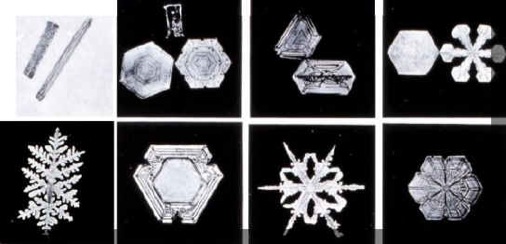Snowflakes form when water vapor freezes into ice crystals in cold clouds. The ice crystals attract cooled water droplets to form various shapes. They get heavy and fall. If the air is cold enough, the snow falls all the way to the earth without melting. If the ground is freezing, the snowflakes stick to the ground. Go here to see how air temperature creates other kinds of precipitation
No Two Alike?
Have you noticed that there are many different shapes of snowflakes? That is because a snowflake is usually made of many different kinds of snow crystals, and the shape of a snow crystal depends a lot on the temperature at which it forms. For example, at temperatures from 25 to 32 degrees F, the crystals are shaped like thin plates. At temperatures between 20 and 25 degrees F they look more like needles and at 15-20 degrees F they resemble hollow columns. Usually the colder the temperature, the smaller the crystals.
As the crystals fall from the cold clouds, they bump into other crystals and freeze together, making even more shapes. This is one reason why it's so hard to have two snowflakes exactly alike. In fact, in air right at the freezing mark, several snowflakes may stick together, forming large clumps of flakes that may melt as they hit the ground.

Snow photographs by Wilson A. Bentley ("Snowflake Bentley") of Jericho, VT
Snow is one kind of weather that people can duplicate. Go here to see how ski resorts make snow for skiing.
Go to Next Page
No Two Alike?
Have you noticed that there are many different shapes of snowflakes? That is because a snowflake is usually made of many different kinds of snow crystals, and the shape of a snow crystal depends a lot on the temperature at which it forms. For example, at temperatures from 25 to 32 degrees F, the crystals are shaped like thin plates. At temperatures between 20 and 25 degrees F they look more like needles and at 15-20 degrees F they resemble hollow columns. Usually the colder the temperature, the smaller the crystals.
As the crystals fall from the cold clouds, they bump into other crystals and freeze together, making even more shapes. This is one reason why it's so hard to have two snowflakes exactly alike. In fact, in air right at the freezing mark, several snowflakes may stick together, forming large clumps of flakes that may melt as they hit the ground.

Snow photographs by Wilson A. Bentley ("Snowflake Bentley") of Jericho, VT
Snow is one kind of weather that people can duplicate. Go here to see how ski resorts make snow for skiing.
Go to Next Page